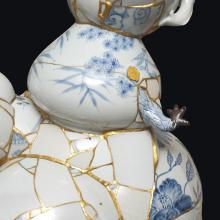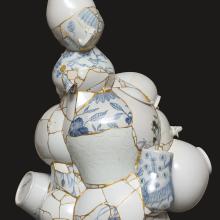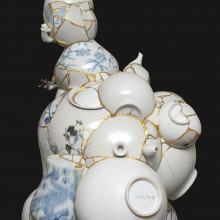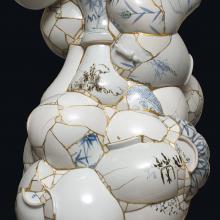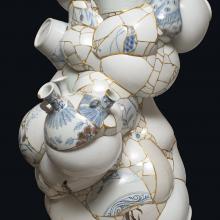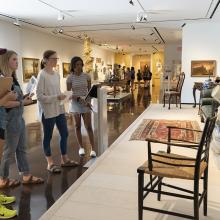2020 Common Work of Art
Translated Vase, Yeesookyung 李受俓

born 1963 Seoul, South Korea
Translated Vase, 2007
ceramic shards, epoxy, 24K gold leaf, 24K gold powder
Museum purchase: Helen Foresman Spencer Art Acquisition Fund, 2012.0033
The KU Common Book program represents a campus-wide initiative to engage first-year students in a shared reading and learning experience. Because of the Covid-19 pandemic, this program has paused for the 2020–2021 academic year. Despite this change, we want to provide opportunities for shared object-based engagement with first-year students and our larger community by continuing the tradition of selecting a KU Common Work of Art. In keeping with the KU Common Book and Common Work of Art’s focus on current issues and events, the 2020 Common Work of Art by Yeesookyung fosters discussions of what it means to create, to repair, and to transform.
Yee’s artistic practice delves deep into Korean history, uncovering fragments of cultural memory that she transforms into new manifestations of contemporary life. The works in her Translated Vase series are composed of broken ceramic pieces she gathers from the waste piles of Korean ceramicists and reimagines as biomorphic sculptures, filling the cracks with gold. Each organically shaped form emerges from a painstaking jigsaw-puzzle process in which Yee creates new connections between disparate shards.
Reversal—such as transforming “trash” into “art”—and the playful manipulation of linguistic meaning is also central to the translation process explored in Translated Vase. While the use of gold lacquer is seemingly related to the Japanese tradition of mending ceramics known as kintsugi, for Yee the choice of gold is based on Korean language and culture. In Korean, the words crack and gold are homonyms, both called geum. She states, “I wanted to add a sense of humor to my work by filling geums (cracks), which are considered as defects, with a valuable material, such as real geum (gold).”
In a 2018 interview, Yee described her Translated Vase series:
“I am attracted to failed, broken or ephemeral things. Things in a broken state provide me with a chance to intervene. It is not about fixing or mending, but about celebrating the vulnerability of the object and ultimately myself. This broken state allows me to explore new narratives which are not bound by hierarchy. The narrative gives rise to a real world, even more concrete that this existing world, built by art practice and filled with countless endeavors to reach sublime beauty. Ironically, the Translated Vase fragments are transformed into a rock-solid state after they are broken, due to the thick layers of epoxy and metal structures inside, to support the forms. They are no longer vulnerable.”
When the Spencer’s galleries reopen to the public, Translated Vase will be on display in the exhibition Empire of Things. This page will continue to be updated with relevant resources for expanding conversation about the 2020 KU Common Work of Art.
Videos
- Watch an interview with the artist (Korean with English subtitles, 8 min.)
- Watch an interview with the artist (English, 2 min.)
- Watch Spencer staff compare historical and contemporary blue-and-white ceramics from Korea (English, 5 min.)
Artist’s website
View other works in the Translated Vase series
Related readings
- Interview with Yeesookyoung
- Robin Wall Kimmerer, “Tallgrass”
- Alice Walker, “I will keep broken things”
- Kerry Hannon, "To Build Emotional Strength, Expand Your Brain"
Related assignments
- Hawk Week 2020 Mindful Collage Activity, University
- Adding Art to the KU Common Book, University
- Engaging with Art and the Common Book, University
- Art Minute Assignment, University
- Strong at the Broken Places & Perfection from Imperfection, K–12




